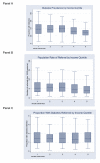Association of socio-economic status with diabetes prevalence and utilization of diabetes care services
- PMID: 17018153
- PMCID: PMC1618393
- DOI: 10.1186/1472-6963-6-124
Association of socio-economic status with diabetes prevalence and utilization of diabetes care services
Abstract
Background: Low income appears to be associated with a higher prevalence of diabetes and diabetes related complications, however, little is known about how income influences access to diabetes care. The objective of the present study was to determine whether income is associated with referral to a diabetes centre within a universal health care system.
Methods: Data on referral for diabetes care, diabetes prevalence and median household income were obtained from a regional Diabetes Education Centre (DEC) database, the Canadian National Diabetes Surveillance System (NDSS) and the 2001 Canadian Census respectively. Diabetes rate per capita, referral rate per capita and proportion with diabetes referred was determined for census dissemination areas. We used Chi square analyses to determine if diabetes prevalence or population rates of referral differed across income quintiles, and Poisson regression to model diabetes rate and referral rate in relation to income while controlling for education and age.
Results: There was a significant gradient in both diabetes prevalence (chi2 = 743.72, p < 0.0005) and population rates of referral (chi2 = 168.435, p < 0.0005) across income quintiles, with the lowest income quintiles having the highest rates of diabetes and referral to the DEC. Referral rate among those with diabetes, however, was uniform across income quintiles. Controlling for age and education, Poisson regression models confirmed a significant socio-economic gradient in diabetes prevalence and population rates of referral.
Conclusion: Low income is associated with a higher prevalence of diabetes and a higher population rate of referral to this regional DEC. After accounting for diabetes prevalence, however, the equal proportions referred to the DEC across income groups suggest that there is no access bias based on income.
Figures
References
-
- Hattersley L. Trends in life expectancy by social class: An Update. Health Statistics Q. 1999. pp. 16–24.
-
- National Public Health Survey. Statistics Canada. 1998. http://www.statscan.ca
Publication types
MeSH terms
LinkOut - more resources
Full Text Sources
Medical
Research Materials


